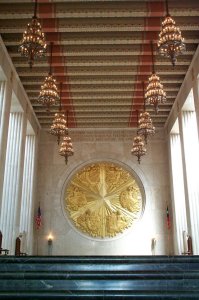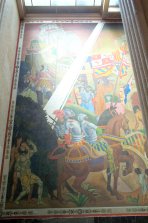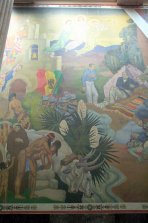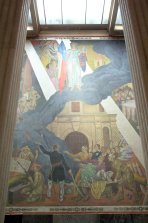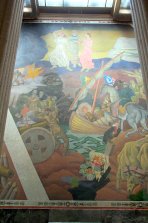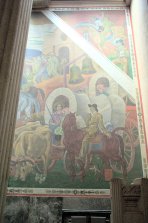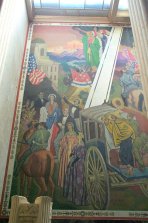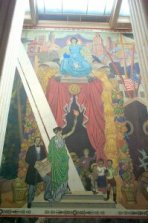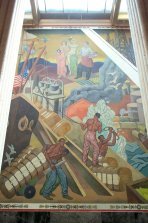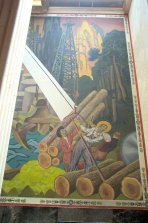![]()
Return to: Texas Hall of State Intro
The Great Hall
|
Because it lies straight ahead through the building's front doors, most visitors naturally gravitate toward the "Great Hall" (or "Hall of Six Flags" as it is also known), accessible up a short flight of marble stairs. Here, one may stand in awe of this tremendous room, its ceiling as high as that of a four-story building, measuring 46 feet from floor to ceiling. From the steps leading up to the Hall to its back wall the room measures 94 feet; from side to side it is 68 feet in width. Just as one is drawn to the Great Hall upon entering the building so are visitors inside the Hall drawn to the huge gold medallion on the center of the back wall. Twelve feet in diameter, the medallion is the work of Joseph E. Renier, a Yale artist and faculty member. Renier, born in America of Belgian parents, was also a graduate of the American Academy in Rome. |
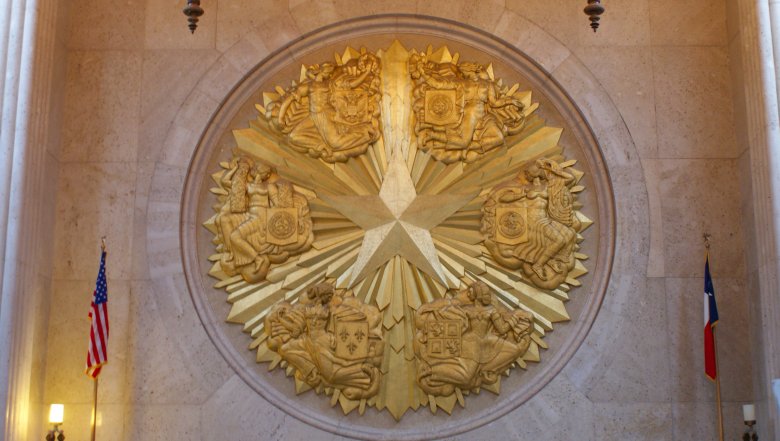
The medallion, like the statues along the Esplanade, symbolizes the six nations which have claimed sovereignty over Texas throughout its long history. In the center is a large five-pointed Lone Star with rays of light extending from it in all directions. Around the star are grouped six female figures representing each of the "Six Flags of Texas." Clockwise, from upper left, they are: The Republic of Texas; Mexico; Spain; France; the Confederate States of America; and the United States of America." Each is appropriately dressed and holds a shield with symbols of the nation she represents; the Lone Star of Texas; the Mexican eagle standing on a cactus with a rattlesnake in its beak; the castles and rampant lions of Spanish royalty; the French fleur-de-lis; and the great seals of the Confederate States and United States, respectively.
The atmosphere in the Great Hall can be likened to a cathedral. Here, one feels compelled to speak in hushed tones and to walk slowly and quietly, drinking in the magnificence and being careful not to disturb the solemnity of the place. Here too, it may be worth considering what makes Texans just a little different from other Americans. A visit to this shrine answers the question by posing another: Does any other state have its equal? Only Texas has a hall of this kind because its history is as unique as that of any nation. Of course, as every Texan knows, the state was in fact a sovereign country for a period of time (albeit briefly). Perhaps it is that fact more than any other which makes Texas a special place in the hearts and minds of its natives. Even Elizabeth II, the Queen of England, acknowledged the uniqueness of Texas when she visited the Hall of State in May 1991. In a speech, she recalled the old story of a West Texas rancher giving his son advice. "Son," said the man, "Never ask a man where he is from. If he is from Texas, he will tell you. If he's not, it isn't polite to embarrass him by asking."
North Wall Murals (Click on each small image to see a larger size.)
In addition to the medallion, the Great Hall's other outstanding features are the huge murals seen on the north and south walls. Unlike most murals, these were not painted directly onto the wall but first on canvas in a studio and then attached to the walls. Here, framed by tall fluted columns of native Texas fossil-shellstone, can be seen the whole panorama of Texas history, from the earliest days of Spanish settlement to modern times, i.e. 1936 - the year the building was constructed. These murals were painted by Eugene Savage of New York, a professor of painting at Yale University in Connecticut. Each mural measures 30 feet by 80 feet. They were completed by Savage in just five months with the help of two Texas artists: James Buchanan "Buck" Winn, Jr. and Reveau Bassett. Two art students, Bill Smith and Lonnie Lyon, also assisted.
Each mural, instead of following a chronological order, begins its theme at either side, culminating in the center panel. The mural on the north wall (to the left when facing the medallion) is of the "Texas of History," its scenes climaxing in the violent birth of the Republic of Texas. On the left side are shown early Spanish explorers Cabeza de Vaca and Coronado along with the French explorers LaSalle and Desoto. Next can be seen Spanish missionaries attempting to bring Christianity to the Indian tribes of Texas. High above them are the angels Poverty, Chastity, and Obedience.
Below the angels stands Mexican President and General Antonio Lopez de Santa Anna dressed in the private's uniform in which he was captured after the Battle of San Jacinto. That event, which took place on April 21, 1836, secured the independence of Texas from Mexico. Santa Anna is shown surrendering to General Sam Houston, who lies with a bullet wound in his leg. Nearby, the scout "Deaf" Smith is seen, cupping his ear with his hand so as to better hear the words spoken between the two men. Below this scene and to the right are portrayed the citizens of Gonzales whose "Come and Take It" taunt started the Texas Revolution in October 1835. A contingent of Mexican soldiers had been sent to take away the cannon the American settlers had earlier been given to defend themselves against the Indians. The Mexican government, rightly so it now seems, was afraid the colonists might use the cannon against its authority. However, by trying to relieve the colonists of their cannon, Mexico triggered the very thing it had hoped to avoid.
In the mural's center is a scene representing the most legendary battle in Texas history, the siege of the Alamo. Shown here, wearing a blue uniform coat, his back to the viewer, stands Colonel William Barret Travis, commandant of the fort. In his right hand he holds the sword with which, according to legend, he drew a line in the dust and challenged the Alamo's men to cross and stay there to perish in the name of liberty. Facing him are a group of men which include Jim Bowie, lying stricken on a cot, James Butler Bonham, shown carrying Bowie's cot (near his feet), and David Crockett, standing tall and erect, his hair slicked down and parted in the middle and wearing not the coonskin cap and buckskins of legend but rather a Congressman's black frock coat and tie. While Crockett had indeed been a U.S. Congressman, it is said that the artist, being a "Yankee" and not so familiar with Texas history, used as a reference a portrait of the legendary backwoodsman painted while he was in Washington representing his Western Tennessee constituents.
The smoke rising above the door of the Alamo chapel represents the funeral pyre of its defenders and the female allegorical figure standing above it, as if rising with the smoke, is symbolic of the Republic of Texas being born from the flames. To this figure's right (viewer's left) stands Stephen F. Austin, the acknowledged "Father of Texas" - so-called for being the first American to settle other Americans in what was once the Mexican province of Texas. Below and to the right of the Alamo are pictured two more famous Texians: James Fannin with his men at the Battle of Concepcion; and Ben Milam, hero of the Battle of San Antonio de Bexar. Both Fannin and Milam died in the Revolution. Fannin and his men were executed by the Mexicans at Goliad. Milam, leading the Texians in battle, was killed in the streets of old Bexar in December 1835.
In the right-hand panels of this mural are scenes depicting earlier attempts to wrest Texas away from Spain by such "filibusters" as James Long and the Gutierrez-Magee Expedition. Also depicted are the "Old Three Hundred," Austin's original colonists, entering Texas.
South Wall Murals (Click on each small image to see a larger size.)
The theme of the mural on the south wall (right-hand side when facing the medallion) is "The State of Texas." In the center, sitting astride two cornucopia spilling their bounty, sits a female figure symbolizing the state. In her lap are flowers (which many a child has mistaken for "doughnuts"). She holds a mysterious blue orb which some observers have jokingly called her "bowling ball." Below her stands another female figure representing "Education". She is holding aloft the torch of knowledge and learning while 1936-era school-children emerge from darkness into the light. Next to her stands Republic of Texas President Mirabeau B. Lamar, who is credited with the establishment of public education in Texas.
On the extreme left of the mural are a number of figures from Texas history standing in a row: Anson Jones - last president of the Republic; Jane Long - wife of James Long and "Mother of Texas"; J. Pinckney Henderson - first governor of the State of Texas; Ashbel Smith - President Jones' Secretary of State; Susannah Dickinson - the only adult Anglo survivor of the Alamo; and Rebecca Fisher - admired for her interest in the general welfare of Texas, she helped save the Alamo as a shrine to Texas history. Also depicted, separate from the others, is Senora Alverez, known as the "Angel of Goliad" - for her attempts to bring aid and comfort to Fannin's sick and dying men. Also pictured in this panel is a tribute to the Indians of Texas and three of Texas' Confederate military leaders: Generals Hood and Johnston and Dick Dowling - hero of the Battle of Sabine Pass.
The next panel depicts three allegorical figures representing the South, Columbia (in the center), and the North. These symbolize the reunion of the North and South into one country following the Civil War. Below are a cowboy astride a white horse, his lariat held high in the air, driving a herd of longhorn cattle and a farmer wielding a shovel near a stream and a flock of sheep.
The panels to the right depict scenes of modern-day industries of Texas including shipping, petro-chemicals, cotton growing, oil production and lumber. The three allegorical figures in this part of the mural are a tribute to, and symbolic of, music, literature and science.
Other Decorative Features
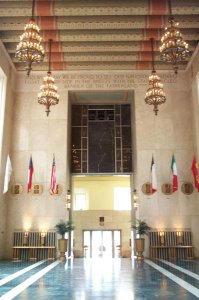 The remainder of the Great Hall is also full of symbolism and imaginative designs. The hand-stenciled ceiling, from which ten large chandeliers hang, was decorated by George Davidson, also a Yale University artist. Depicted in an Aztec-like style are roadrunners, rattlesnakes and armadillos. The colors of the ceiling - brown, green and blue, represent the earth, the sea, and the sky.
The remainder of the Great Hall is also full of symbolism and imaginative designs. The hand-stenciled ceiling, from which ten large chandeliers hang, was decorated by George Davidson, also a Yale University artist. Depicted in an Aztec-like style are roadrunners, rattlesnakes and armadillos. The colors of the ceiling - brown, green and blue, represent the earth, the sea, and the sky.
The floors, made of dark green Vermont marble with silvery-white inlaid stripes of San Saba stone from Central Texas, include depictions of the native wildlife of Texas laid out in mosaic tile. These animals include: a fish; a horned toad; a wild boar; a prairie dog; a mockingbird; an eagle; an alligator; a rattlesnake; an armadillo; a jack-rabbit; a roadrunner; and a wild turkey.
Hanging from flag-staffs at the rear of the Hall are the Six Flags of Texas. Facing them (looking toward the steps) they are, from left to right: France; the Confederacy; the United States; the Republic of Texas; Mexico; and Spain. Some visitors will not recognize the Confederate flag; it is not the battle flag so many are familiar with but rather the official flag of the Confederate government. The United States flag, unless it has been replaced with one more modern since this book was written, bears only forty-eight stars - the number of states in the Union at the time of the 1936 Centennial Exposition.
The large silver doors which line either side of the hall are usually closed. They were kept open when the building was new (and had no air-conditioning) as a means of ventilating the hall. In place of one of the south doors, is a marble wall to which is attached a bronze medallion honoring George B. Dealey, aforementioned vice-president of The News and former president of the Dallas Historical Society. Because of the door's crypt-like appearance, there are some visitors (usually children) who wonder if Mr. Dealey is buried behind it.
Other objects of note in the Great Hall include various large decorative urns and highbacked chairs placed in front of each column, adding a touch of human scale to what would otherwise be an overwhelmingly empty space.
Before leaving the Great Hall, it is worth noting the words carved in large letters above the entrance to the room. They were spoken by Mirabeau B. Lamar, President of the Republic of Texas, in 1837 and expressed the desire of Lamar (and many other Texans) to see the Lone Star republic become part of the United States:
"And well may we be proud to see our national standard float side by side in the breeze with Star Spangled Banner of the Fatherland."
Less than ten years later Lamar's dream came true. As a follow-up to his statement, the immortal words of another Republic of Texas president - Anson Jones, are carved in the rear wall above the gold medallion. These words were spoken by Jones in 1846, in reference to Texas' annexation by the United States:
"The Lone Star of Texas has passed on and become fixed in that glorious constellation which all freemen and lovers of freedom must reverence and adore - the American Union."
Principal Information Sources:
- The author's own training and experience as a volunteer tour guide at the Hall of State, 1985-1990.
- A Gathering of Symbols: Texas History in the Hall of State (Dallas: Dallas Historical Society and the Junior League of Dallas, Inc., 1985).
Copyright © 1996-2012 by Steven Butler, Ph.D. All rights reserved.
